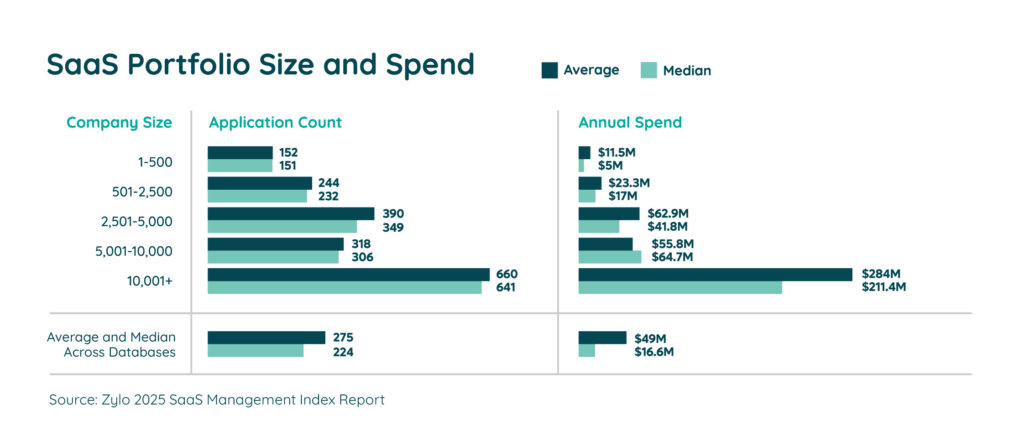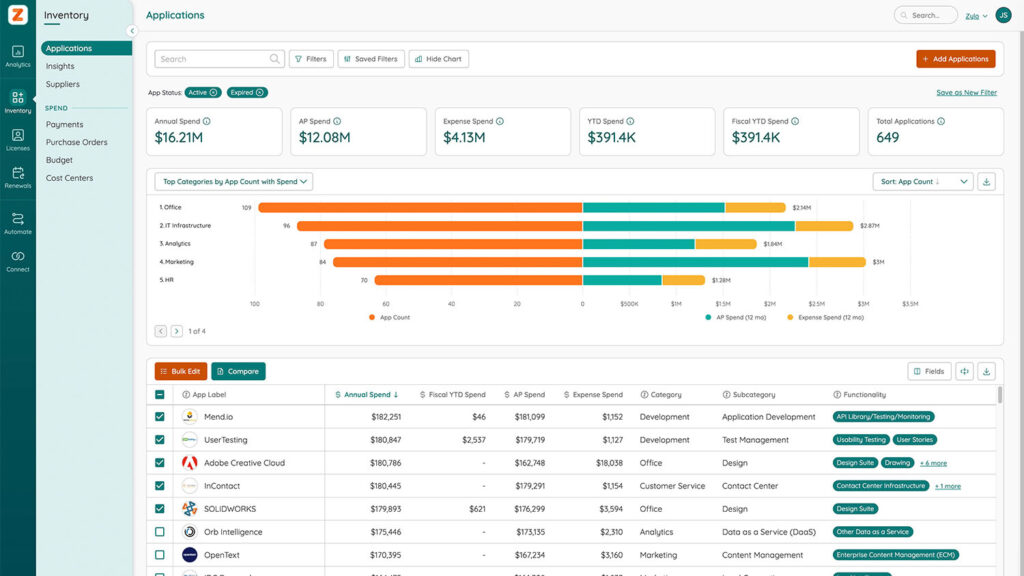Table of Contents
Every year, more and more SaaS products promise to save your organization time and money (not to mention saving you from headaches).
But there’s a flip side to this: Every year, it gets harder to keep track of all the SaaS vendors you’re contracted with, let alone assess the value that you’re getting from them.
That’s where SaaS Management comes in.
SaaS Management is the holistic business practice of proactively managing, optimizing, and governing all the SaaS applications within a company’s portfolio. It includes strategically operationalizing inventory, license, and renewal management at scale to ensure efficient and cost-effective use of SaaS resources. To be successful, it requires alignment and collaboration between IT, Software Asset Management (SAM), and Procurement.
It has never been more urgent to implement a SaaS Management strategy at your organization. Why? Gartner’s strategic planning assumptions in its first-ever 2024 Magic Quadrant for SaaS Management Platforms explain:
- Through 2027, organizations that fail to centrally manage SaaS life cycles will remain five times more susceptible to a cyber incident or data loss due to incomplete visibility into SaaS usage and configuration.
- Through 2027, organizations that fail to attain centralized visibility and coordinate SaaS life cycles will overspend on SaaS by at least 25% due to unused entitlements and unnecessary, overlapping tools.
- Through 2027, over 50% of organizations will centralize SaaS application management using a SaaS Management Platform (SMP), an increase from less than 10% in 2024.
But how do you get started managing SaaS?
2024 Gartner® Magic Quadrant™ for SaaS Management Platforms
Learn MoreThe One Thing You Need to Do First: Get Visibility into All Your Apps
Consider your weekly grocery run. You wouldn’t go to the store or open up Instacart without taking stock of what’s in your pantry. If you did, you may buy things you already have and spend more money than necessary. Over time, you risk wasting food and blowing your grocery budget.
The same goes for your SaaS applications.
When you don’t know what apps you have and how much you’re spending, it’s difficult to effectively manage software costs, mitigate security and compliance risks, and drive operational efficiency. You’re likely to run into overages, purchase redundant software, weaken your security posture, waste licenses – the list goes on.
If you’re unsure of what you have, you’re not alone. It’s common for companies to underestimate SaaS spending and the size of their portfolios. In fact, our data shows that on average, they spend 3X more and have 1.7X more applications than they think.
How does that look in reality? Here’s a look at portfolio size and spend for different sized companies.

To start managing SaaS, step one is inventory management. It is the foundation upon which your SaaS Management program is built, providing complete, ongoing visibility into your stack.
When you begin with visibility into your full inventory, it provides the requisite strategic direction for the rest of your program. You can’t programmatically manage licenses and renewals until you tackle visibility first.
What Is SaaS Inventory Management?
Inventory management is an organization’s comprehensive, categorized, and continuous source of truth and reporting for SaaS. It enables you to see and understand every application in your ecosystem and associated spending and risks across your organization.
Using a SaaS Management Platform (SMP) for inventory management makes it easy to:
- See a holistic view of your SaaS ecosystem – all your apps, spend, and risk.
- Get real-time insights on where you can optimize spending, increase purchasing efficiency, eliminate shadow IT, and improve your security posture.
- Streamline management tasks with automation, such as discovery and building your system of record.
- Improve collaboration between IT, Software Asset Management, Procurement, and business leaders.
- Make more informed decision-making with centralized data and actionable reporting.

Benefits of SaaS Discovery and Inventory Management
Once you’ve discovered all your applications and built a system of record, there are a few advantages you unlock.
- Gain awareness of security risks and put controls in place to protect the business.
- Establish clear ownership of applications to maintain accountability and proper management of each tool.
- Make informed rationalization decisions to reduce waste and save money.
- Forecast and plan budgets more accurately and improve financial management with insight into spending trends.
- Detect employee-expensed apps (shadow IT) to control unauthorized usage and spending.
- Immediately see new SaaS applications entering the business to ensure compliance and avoid risk.
- Improve the employee experience by making it easier for employees to find and use the tools they need.
Adobe Drives Innovation and Massive Savings with Zylo
In the past 4 years, Adobe has rapidly scaled from $9B to $18B. This growth has made an already complex environment even more complex. Learn how they leveraged Zylo to get complete visibility into their SaaS portfolio, unlock millions in cost savings and avoidance and improve the employee experience.
How to Get Complete Visibility of All Your SaaS Apps
Have you ever been asked to track down all the applications at your company? Considering that the average enterprise has 650 applications, that’s bound to make you start sweating.
Doing it manually with a legacy software asset management tool or spreadsheet makes it all the more difficult. You start with what you know about: your IT-owned applications. Then, it takes weeks or months of reaching out to the business to track down what you don’t know about. Even then, you’re still missing apps and haven’t accounted for everything that’s been purchased during that time period.
If you’re thinking, “There has to be a better way.” You’re right, there is.
Instead, use a SaaS Management Platform to take that manual work off your plate. An SMP automates the SaaS discovery process, providing you with complete and ongoing visibility into your apps and their associated spend and risks.

SaaS Discovery Methods
Across the market, you’ll find a variety of different discovery methods in use with varying levels of effectiveness.
- Financial, AI-powered and rule-based matching
- Browser extension
- Cloud access security brokers (CASB)
- Single sign-on
At Zylo, our AI-powered financial discovery continuously uncovers and categorizes your SaaS applications, detecting new ones as they’re added – regardless of the purchase method. It is most effective at uncovering shadow IT and unknown expense purchases.
“Zylo provided the AI we used to identify current titles and categorize them according to functional area, saved approximately 500 hours at the onset of the project and became the backbone of how we divided our software portfolio.”
— Vinod Vishwan, Sr. Director, Head of Business Planning & Operations at Adobe
Centralize Key Application Data
Without data, you’re likely to resort to guesswork and base decisions on opinions. Visibility into your apps and spending isn’t enough. Rather, key application and business data must be centralized in a system of record to drive outcomes.
For example, tracking application owners makes it easy to know who to collaborate with on an upcoming renewal, which allows you to spend your time more wisely. Likewise, understanding the security risk score for each application helps you easily pinpoint those you may want to deprecate to remove that risk.
Below are some examples of useful data to include in your system of record:
- App metadata: supplier name, annual spend, cost centers, internal identifiers, app criticality, and information sensitivity – to name a few
- IT, business, and application owners
- License and usage data
- Order forms / contracts
As a house will not stand without a solid foundation, your SaaS Management program will fall flat without visibility.
“The visibility into your SaaS data that Zylo provides allows you to take action. And when you can take action based on information, you’re making decisions that will then result in savings.”
— Karen Hodson, Global Procurement & Real Estate Officer, Marigold
Start SaaS Management with Zylo
More than eight years ago, Zylo created the SaaS Management category, and we’ve maintained our position as the leader in the market ever since. Over that time, we’ve seen it all.
We’ve witnessed those eye-opening moments when an enterprise realizes just how big of a problem SaaS has become. But we’ve also been there for the moments when these same teams score remarkable wins for their organizations, like reclaiming millions of dollars in wasted spend.
If there’s one thing we’ve learned, it’s this: Discovery and inventory management is the bedrock of enterprise SaaS Management. To make better decisions, you must have better data.
That’s why we created Zylo Discover, the industry’s first standalone SaaS discovery and inventory solution. By delivering a single source of truth, it enables enterprise IT leaders to:
- Increase operational efficiency. Build a continuous and definitive system of record of all applications and their owners. Save time and manual effort tracking and managing software in spreadsheets.
- Ensure responsible software spending. Control spend, inform budgeting, and uncover purchasing efficiencies with centralized spend data. Find and cut redundant applications and track savings over time with detailed and actionable reporting.
- Improve security and risk management. Identify all new applications in real time to find and eliminate shadow IT. Pinpoint security risks with ongoing audit control of new purchases.
Want to start SaaS Management in 2025?
Let us help you jump start your SaaS Management program and build a roadmap to success. Learn how Zylo Discover works and its powerful use cases for your business. To see it in action, request your personalized demo.


 — Vinod Vishwan, Sr. Director, Head of Business Planning & Operations at Adobe
— Vinod Vishwan, Sr. Director, Head of Business Planning & Operations at Adobe — Karen Hodson, Global Procurement & Real Estate Officer, Marigold
— Karen Hodson, Global Procurement & Real Estate Officer, Marigold